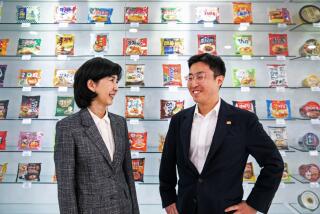The Hamburger of the Future?
- Share via
TOKYO — Move over, McDonald’s. Japanese and South Korean companies are hoping that instant noodles will soon join such staples as borscht and goulash on the dining tables of Eastern Europe and the Soviet Union.
If successful, this would mark yet another conquest by a product dreamed up slightly more than 30 years ago as a way of marketing inexpensive and abundant American wheat.
In the latest assault, Japan’s Toyo Suisan Kaisha plans to ship 30 million packets of noodles annually to Eastern European countries and has targeted the Soviet Union in particular.
It plans to ship 20% of the production of a U.S. factory due to start operations in June, a company spokesman said.
“This is a big challenge for us because both Eastern and Western Europe are virgin markets for us,” he said. “But demand there is expected to be strong, because the population of the Soviet Union alone is 1.5 times greater than that of the United States.”
The U.S. market for instant noodles has grown rapidly to $300 million a year from nothing 20 years ago, the spokesman said.
“Instant noodles have become the best-known Japanese food in the world. Even sushi and soy sauce are only popular in some parts,” said Tsutomu Kobayashi, an official at the Japan Convenience Foods Industry Assn.
Some 13 billion packets of instant noodles a year are sold in 80 countries, association figures show.
Nissin Food, the company that pioneered instant noodles, also plans to export the product to Eastern European countries beginning next year, a company spokesman said.
It hopes to export from a factory in India, due to open in December. The plant is a joint venture with Brooke Bond and Company, a British subsidiary of the Anglo-Dutch conglomerate Unilever.
The plant will be exporting four million packets, or one-tenth of its output, to Eastern Europe and the Soviet Union by 1992, the spokesman said.
The Samyang Food Co. of South Korea said that it hoped to begin exporting noodles to the Soviet Union. It will ship two container loads worth $20,000 to test the market, a company spokesman said.
Japan started exporting instant noodles in 1960, just two years after they were invented by Momofuku Ando, Nissin’s founder.
Ando came up with the idea of an inexpensive, nutritious and convenient food suited to the Japanese palate and made easily from the ample stocks of wheat given to Japan by the U.S. government after the end of World War II.
“At the time, people were starving and lining up for noodles at street stalls,” said Tastuya Ukon, a Nissin spokesman.
Imported wheat still accounts for most Japanese production of the food, known here as ramen and in Korea as ramyon.
The idea of selling noodles in disposable foam cups --enabling diners to cook them simply by adding hot water--was introduced in Japan in 1971.
The latest innovation, also introduced by Nissin, is self-heating containers.
In 1989, instant noodle output in Japan reached 4.6 billion packages.
“We are sure instant noodles will become popular in every country,” said Nissin’s Ukon.
More to Read
Eat your way across L.A.
Get our weekly Tasting Notes newsletter for reviews, news and more.
You may occasionally receive promotional content from the Los Angeles Times.










